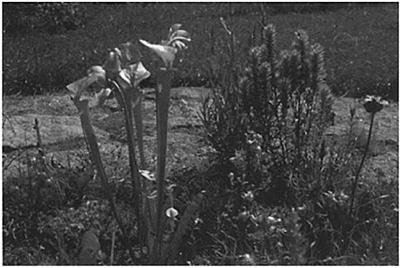Natural swimming ponds are becoming popular in Austria and Germany as a natural alternative to pools treated with chemicals. These pools have many advantages. They combine the ornamental character of richly vegetated pond margins with the recreational feature of the swimming pool. They enable wetland vegetation to be established in a water body where space may otherwise be limited. They support a wide range of pond wildlife and they filter pool water in a natural, chemical-free manner.
To obtain clear water, nutrient input must be minimised; it is worth striving for oligotrophic quality. One of the most common systems works by pumping water from the surface and bottom of the bathing area, which is planted only along the edges, into the regeneration zone filled with dense, proliferating vegetation. From there it flows back again into the main body of the pond (see Figure 8.24). It is not the direct uptake of nutrients by the plants, but microbiological reactions at the surfaces of substrate particles and plants that cause the intended cleaning effects. The most effective purifiers are rampantly spreading helophytes and hydrophytes with aerenchyme-containing rhizomes, referred to as ‘monoculture species’ in Table 8.2,
|
|
8.25
Transition-bog planting at the edge of a swimming pond in the author’s
garden—Sarracenia flava beside Castilleja miniata, a hemi-parasite that is presumed on the roots of Carex flava and Lythrum salicaria ‘Robert’
‘shallow water and swamp area’ and iris species or Asclepias incarnata. Irispseudacorus and Mentha aquatica improve hygiene by emitting bactericide substances, if the water depth is sufficient. Planted at a high density, tussock plants with intensive root systems are suitable, such as Carex elata. Ceratophyllum, Stratiotes and Potamogeton species are suitable submerged plants.
The regeneration zone is most effective when it is narrowly shaped or even takes the form of a stream because then the increased water movement brings about improved nutrient supply of demanding vegetation. On the other hand, the nearly motionless water of the wider swimming zone is responsible for the very low nutrient supply of the planting along its edges (Figures 8.25 and 8.26). Here plants from meso – or even nature sites are susceptible to nutrientdeficiency symptoms, so these are therefore optimal conditions for oligotrophic bog and fen vegetation. More or less narrow strips of this vegetation around the swimming area surprise the users with unusual effects: frogs and other animals can be watched easily from inside the pond between a low-growing vegetation of insectivorous plants, orchids, cotton grasses and other specialities. Occasional heavy waves have no negative effect to the planting when the substrate surface lies more than 10 cm above water level. There should be no plants under the water surface in the sphere of influence of the swimming zone, because their dying leaves would cause unpleasant mud-accumulation and whirling up of organic particles. Only Water Lilies can be accepted here. Their leaves can easily be cut and removed in autumn.




